- Created by Phillip Hanegan, last modified on Apr 07, 2020
You are viewing an old version of this page. View the current version.
Compare with Current View Page History
« Previous Version 3 Current »
The EmpowerID Universal Connector allows organizations to use their own internal DB resources to easily create both simple and advanced connectors for their directories and applications. In this topic, we demonstrate how to perform the administrative tasks necessary for using the Universal Connector to connect to an external system. These tasks include the following:
Creating the Universal Connector database
Setting up the Universal Connector account store
To create the Universal Connector database, you will need the following SQL scripts:
SchemaGeneration.sql — This script generates the tables, stored procedures and other database objects used by EmpowerID to store and maintain the identity information imported into the intermediary database from an external data store. You can download the script (UCv2SchemaGenerationScript) here.
DataGeneration.sql — This script generates data that is used by EmpowerID to explain the type of changes that have occurred to any of the business objects in the Universal Connector database via an EmpowerID workflow. You can download this script here. The script is only necessary if you are using the Changelog to batch process changes. When possible, EmpowerID recommends real-time processing over batch processing.
If you are already using an older version of the Universal Connector (versions prior to EmpowerID 2016), instead of running the SchemaGeneration.sql, you need to upgrade the schema for the existing Universal Connector database. To do so, download the upgrade script (UCv1tov2upgradescript) here and execute it against the database.
How to create the Universal Connector database
On any EmpowerID server with SQL Management tools installed, open Microsoft SQL Server Management Studio (SSMS).
In Object Explorer, right-click Databases and select New Database.
In the New Database window that opens, type a name for the database in the Database name field, set the Initial Size to 100 MB and then click OK.
From the new Universal Connector database, open the SchemaGeneration.sql file you received from EmpowerID and execute the script.
This generates the tables EmpowerID uses to maintain the identity information you import into EmpowerID as well as a number of stored procedures for querying and manipulating the data in those tables.
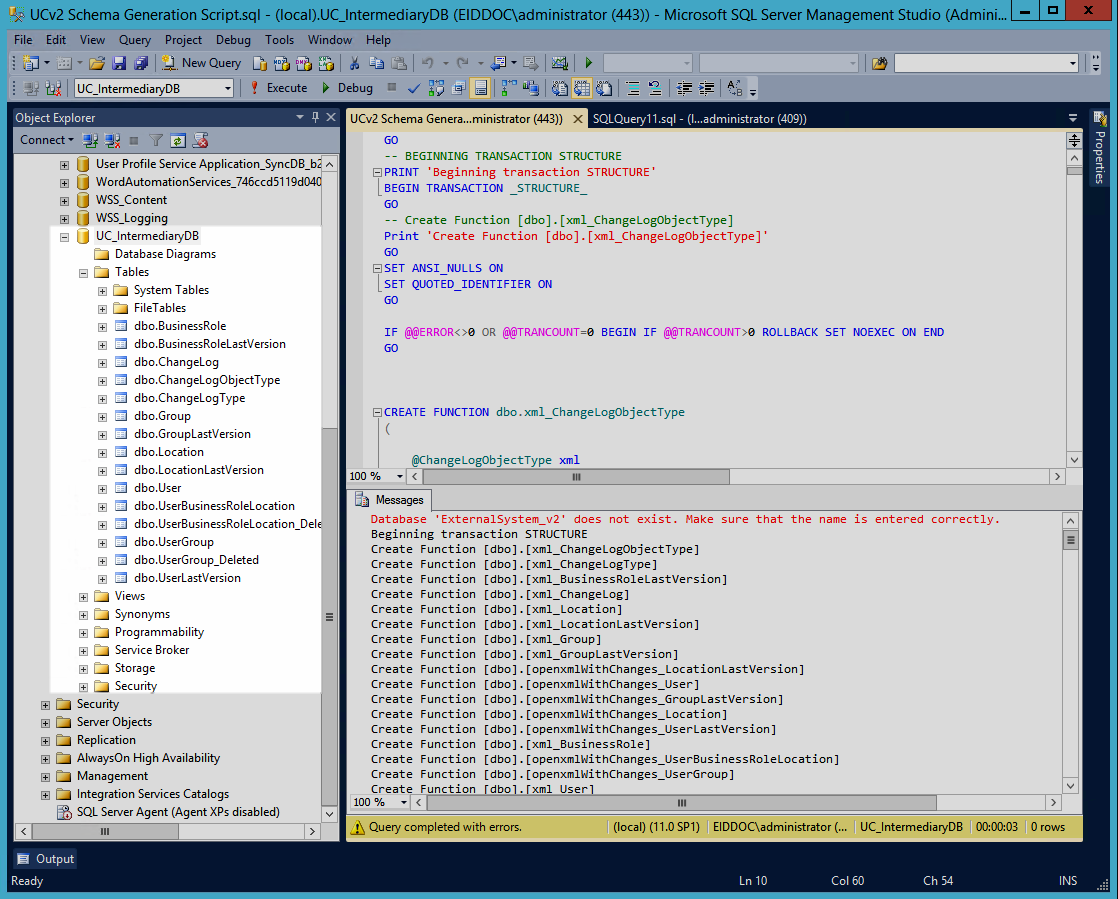
Next, if you plan to use the ChangeLog for batch processing instead of real-time processing of the changes to your data, open the DataGeneration.sql script you received from EmpowerID and execute the script to populate the ChangeLogObjectType and ChangeLogObjectType tables of the Universal Connector database. These tables work in conjunction with the ChangeLog table to explain the types of changes that have occurred to objects in EmpowerID, when the Universal Connector is operating in batch mode.
How to set up the Universal Connector account store
On the navbar, expand Admin > Applications and Directories and then click Account Stores and Systems.
On the Account Stores page, click Create Account Store.
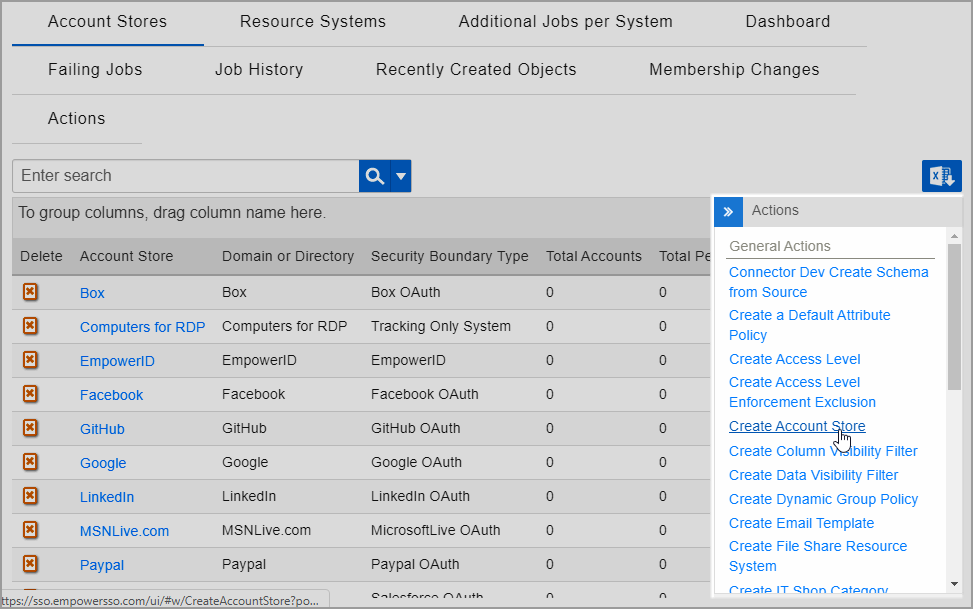
Under System Types, search for Universal Connector.
Click Universal Connector to select the type and then click Submit.
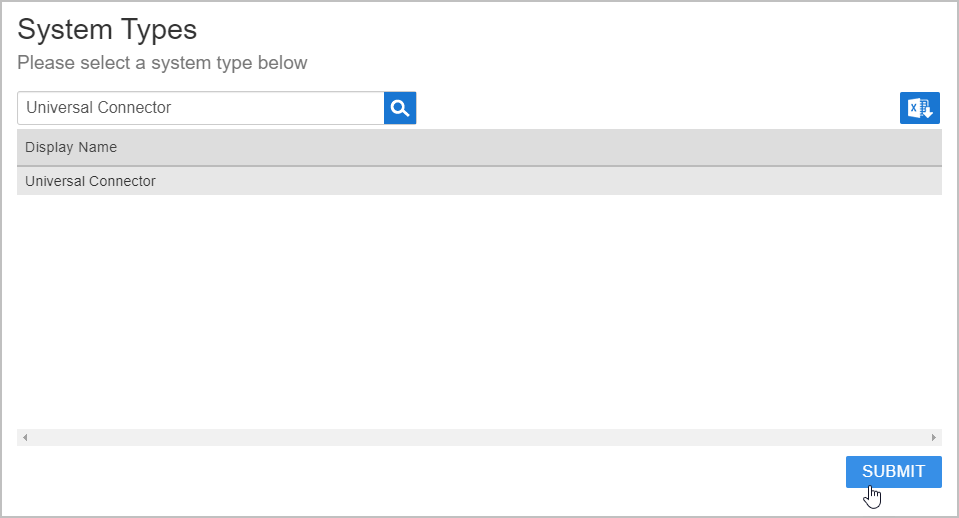
On the Standard Connector Settings form that appears, fill in the following information:
Name and Display Name — Enter a name for the account store.
Is Remote (Requires Cloud Gateway) — This setting appears for account stores with local directories, such as Active Directory, LDAP, SAP, etc. When enabled, this tells EmpowerID to use the Cloud Gateway Connection for that account store. The Cloud Gateway Connection must be installed on an on-premise machine. For installation information, please see Installing the EmpowerID Cloud Gateway Client.
When ready, click Submit.
If you selected Is Remote (Requires Cloud Gateway), search for and select one or more cloud gateway servers and then click Submit. You will not see this screen if you did not select Is Remote (Requires Cloud Gateway).
EmpowerID creates the account store and the associated resource system for it. The next step is to configure attribute flow between the account store and EmpowerID.
EmpowerID supports the configuration of attribute synchronization rules for flowing attribute changes between directories and the EmpowerID Identity Warehouse. Attribute Flow rules are visually configured and are always relative to the relationship between an attribute in a directory and the corresponding attribute in the EmpowerID Identity Warehouse. Attribute Flow rules define the specific fields and attributes that are synchronized between the EmpowerID Identity Warehouse person objects and the external user accounts to which they are linked. Additionally, Attribute Flow rules can be weighted by account store. For example, if you have connected EmpowerID to an HR system as well as Active Directory, and you want any changes made to an attribute in the HR system to take priority over changes made in Active Directory or EmpowerID (while allowing changes to be made in any system), you would give a higher score for each CRUD operation originating from the HR account store and correspondingly lower scores for the Active Directory account store. The following flow rules are available: No Sync ( Red Circle) — When this option is selected, no information flows between EmpowerID and the native system. Bidirectional Flow (Bidirectional Green Arrow) — When this option is selected, changes made within EmpowerID update the native system and vice-versa. For most attributes, this is the default setting. Account Store Changes Only (Left Pointing Arrow) — When this option is selected, changes can only be made in the native system and are then passed to EmpowerID. EmpowerID Changes Only (Right Pointing Arrow) — When this option is selected, changes can only be made in EmpowerID and are then passed to the native system. The following CRUD operations are available: Create — This operation is used to create an attribute value for an existing attribute when the value of that attribute is null. Update — This operation is used to update the value of an attribute. Delete — This operation is used to delete the value of an attribute. From the Account Stores tab of the Account Stores and Systems page, search for the account store you just created and click the Account Store link for it. Click the Attribute Flow Rules tab to view the current rules for the account store. Please note that the attributes available depend on the account store. To change the flow for an attribute, click the Attribute Flow drop-down located between the Person Attribute column and the External Directory Attribute column, and select the desired flow direction from the context menu. To change the score for any of the available CRUD operations (Create, Update and Delete), enter the new score in the appropriate field. By default, scores are weighted evenly, which means that a change to an attribute originating in one connected external directory has the same authority as a change to an attribute occurring in another connected external directory. EmpowerID only considers scores for attribute CRUD operations when multiple account stores with the same user records are connected to EmpowerID, such as would be the case if an HR System and this account store were being inventoried by EmpowerID.attributeflowrules.mp4
Now that the attribute flow has been set, the next steps include configuring the account store and enabling EmpowerID to inventory it.
To configure account store settings
On the Account Store and Resource System page, click the Account Store tab and then click the pencil icon to put the account store in edit mode.

This opens the edit page for the account store. This page allows you to specify the account proxy used to connect EmpowerID to your Active Directory as well as how you want EmpowerID to handle the user information it discovers in Active Directory during inventory. Settings that can be edited are described in the table below the image.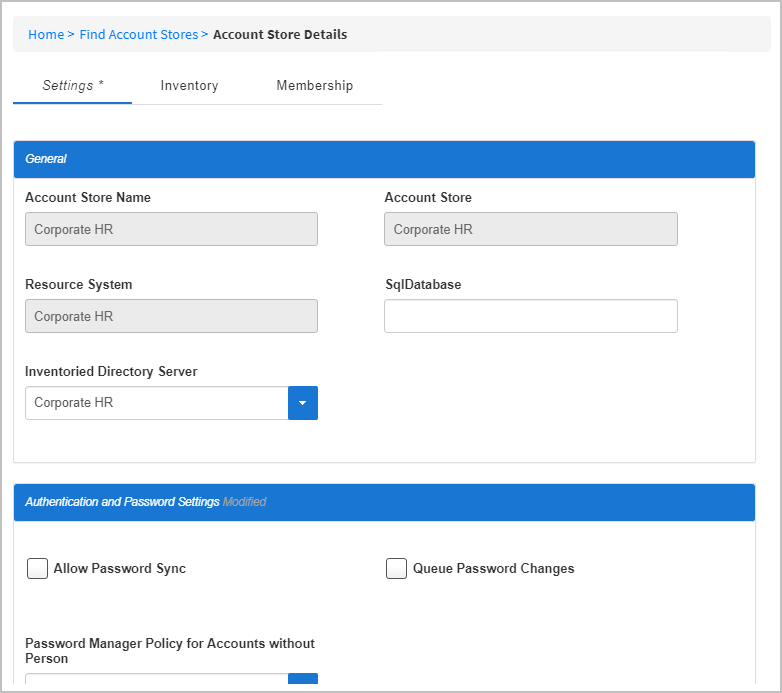
Account Store Settings
Setting
Description
General Settings
SqlDatabase
This is the connection string to the Universal Connector (UC) database you created on the EmpowerID SQL Server. The format for the connection string is: Data Source=<Name of your SQL Server instance>;Initial Catalog=<Name of the UC database>;Integrated Security=True
Inventoried Directory Server
Allows you to select the directory server for the account store. For the universal connector, this is the resource system for the connector.
Authentication and Password Settings
Allow Password Sync
Enables or disables the synchronization of password changes to user accounts in the domain based on password changes for the owning person object or another account owned by the person. This setting does not prevent password changes by users running the reset user account password workflows.
Queue Password Changes
Specifies whether EmpowerID sends password changes to the Account Password Reset Inbox for batch processing.
Password Manager Policy for Accounts without Person
Specifies the Password Manager Policy to be used for user accounts not joined to an EmpowerID Person.
Provisioning Settings
Allow Person Provisioning (Joiner Source)
Specifies whether EmpowerID Persons can be provisioned from user accounts in the account store.
Allow Attribute Flow
Specifies whether attribute changes should flow between EmpowerID and the account store.
Allow Provisioning (By RET)
Allows or disallows the Resource Entitlement (RET) Inbox process to auto-provision accounts for this domain for users who receive RET policy-assigned user accounts, but have not yet had them provisioned.
Allow Deprovisioning (By RET)
Allows or disallows the Resource Entitlement Inbox process to auto de-provision accounts for this domain for users who still have RET policy-assigned user accounts, but no longer receive a policy that grants them a user account in the domain. De-provisioning only occurs if the de-provision action on the Resource Entitlement policy is set to De-Provision.
Allow Account Creation on Membership Request
Specifies whether EmpowerID creates user accounts in the account store when an EmpowerID Person without one requests membership within a group belonging to the account store.
Default Person Business Role
Specifies the default EmpowerID Business Role to be assigned to each EmpowerID Person provisioned from the user accounts in the account store.
Default Person Location (leave blank to use account container)
Specifies the default EmpowerID Location to be assigned to each EmpowerID Person provisioned from the user accounts in the account store.
Directory Clean Up Enabled
Directory Clean Up Enabled
Specifies whether the SubmitAccountTermination permanent workflow should claim the account store for processing account terminations. When enabled, the workflow . When enabled, accounts in the account store that are marked for deletion are first moved into a external directory, disabled and finally deleted when approved. This process involves setting a number of system settings in EmpowerID and requires multiple approvals before an account is finally removed from the account store.
Report Only Mode (No Changes)
When enabled, a report of what the Directory Clean Up process would do is written to the log. The process itself is ignored and all accounts are set to Termination Pending,
Special Use Settings
Automatically Join Account to a Person on Inventory (Skip Account Inbox)
Specifies whether EmpowerID should attempt to join user accounts in the account store to an existing EmpowerID Person during the inventory process. When enabled, the Account Inbox is bypassed.
Automatically Create a Person on Inventory (Skip Account Inbox)
Specifies whether EmpowerID should create new EmpowerID Persons from the user accounts discovered in the account store during the inventory process. When enabled, the Account Inbox is bypassed.
Show in Location Tree
Specifies whether the account store shows in the Location Tree within the EmpowerID UI.
Queue Password Changes on Failure
Specifies whether EmpowerID should send password changes to the Account Password Reset Inbox only when the change fails.
Use Secure LDAPS Binding
Specifies whether to use secure LDAPS binding (for LDAP directories).
Inventory Settings
Inventory Schedule Interval
Specifies the time span that occurs before EmpowerID performs a complete inventory of the account store. The default value is 10 minutes.
Inventory Enabled
Allows EmpowerID to inventory the user information in the account store.
Membership Settings
Membership Schedule Interval
Specifies the time span that occurs before EmpowerID runs the Group Membership Reconciliation job. The default value is 10 minutes.
Enable Group Membership Reconciliation
Allows EmpowerID to manage the membership of the account store’s groups, adding and removing user to and from groups based on policy-based assignment rules.
Edit the account store as needed and then click Save to save your changes.
Now that everything is configured, you can enable the Account Inbox Permanent Workflow and monitor inventory. Be sure inventory is enabled on the account store settings page.
| AccountInboxPW.mp4
|
Monitor inventory
On the navbar, expand System Logs > Policy Inbox Logs and click Account Inbox.
The Account Inbox page appears. This page provides tabbed views of all information related to processing new user accounts discovered in a connected account store during inventory. An explanation of these tabs follows.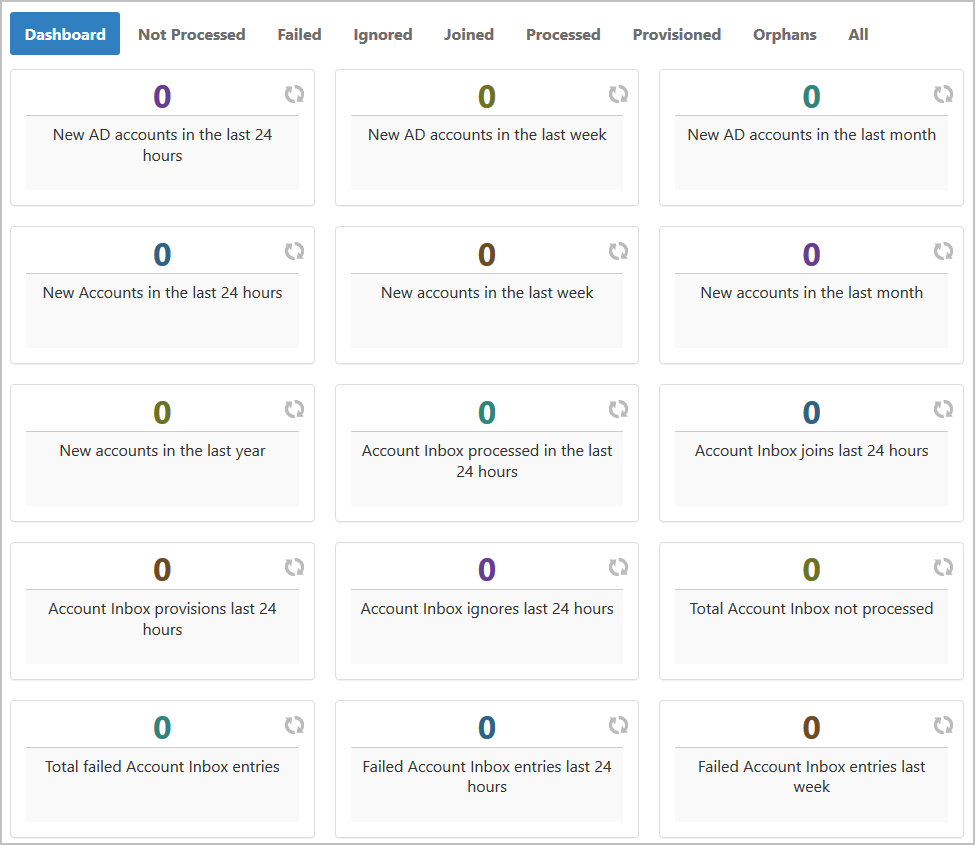
Dashboard — This tab provides a quick summary of account inbox activity.
Not Processed — This tab displays a grid view of all inventoried user accounts not yet used to provision a new EmpowerID Person or joined to an existing Person. Any accounts that fail to meet the Join and Provision rules are displayed here as well.
Failed — This tab displays a grid view of any account joining or provisioning failures.
Ignored — This tab displays a grid view of all accounts ignored by the account inbox. Accounts are ignored if they do not qualify as user accounts.
Joined — This tab displays a grid view of all accounts joined to an EmpowerID Person. Joins occur based on the Join rules applied to the account store.
Processed — This tab displays a grid view of all accounts that have been used to either provision a new EmpowerID Person or joined to an existing EmpowerID Person.
Provisioned — This tab displays a grid view of all accounts that have been used to provision an EmpowerID Person. Provisioning occurs based on the Provision rules applied to the account store.
Orphans — This tab displays a grid view of all user accounts without an EmpowerID Person.
All — This tab displays a grid view of all user accounts and the status of those accounts in relation to the Account Inbox.
IN THIS ARTICLE
- No labels